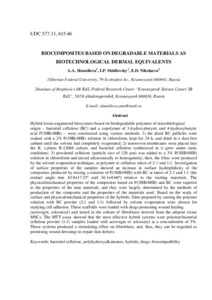Biocomposites Based on Degradable Materials as Biotechnological Dermal Equivalents
Скачать файл:
URI (для ссылок/цитирований):
http://journal.sfu-kras.ru/number/71711https://elib.sfu-kras.ru/handle/2311/111126
Автор:
Anna A. Shumilova
Ivan P. Shidlovsky
Elena D. Nikolaeva
Коллективный автор:
Институт фундаментальной биологии и биотехнологии
Базовая кафедра биотехнологии
Дата:
2018-05Журнал:
Journal of Siberian Federal University. BiologyБиблиографическое описание:
Anna A. Shumilova. Biocomposites Based on Degradable Materials as Biotechnological Dermal Equivalents [Текст] / Anna A. Shumilova, Ivan P. Shidlovsky, Elena D. Nikolaeva // Journal of Siberian Federal University. Biology: Biology. — 2018. — Т. 11 (№ 2). — С. 131-137Текст статьи не публикуется в открытом доступе в соответствии с политикой журнала.
Аннотация:
Hybrid tissue-engineered biosystems based on biodegradable polymers of microbiological origin – bacterial cellulose (BC) and a copolymer of 3-hydroxybutyric and 4-hydroxybutyric acid
P(3HB/4HB) – were constructed using various methods: 1) the dried BC pellicles were soaked with a 2% P(3HB/4HB) solution in chloroform, kept for 24 h, and dried in a dust-free cabinet until the solvent had completely evaporated; 2) nonwoven membranes were placed into the K. xylinus B-12068 culture, and bacterial cellulose synthesized in it grew under static conditions; 3) powdered cellulose (particle size of 120 μm) was added to a 3% P(3HB/4HB) solution in chloroform and mixed ultrasonically to homogeneity; then, the films were produced by the solvent evaporation technique, at polymer to cellulose ratios of 2:1 and 1:1. Investigation of surface properties of the samples showed an increase in surface hydrophilicity of the composites produced by mixing a solution of P(3HB/4HB) with BC at ratios of 2:1 and 1:1 (the contact angle was 43.9±17.55° and 36.1±0.66°) relative to the starting materials. The physical/mechanical properties of the composites based on P(3HB/4HB) and BC were superior to the properties of the neat materials, and they were largely determined by the methods of production of the composite and the properties of the materials used. Based on the study of surface and physical/mechanical properties of the hybrids, films prepared by
casting the polymer solution with BC powder (2:1 and 1:1) followed by solvent evaporation were chosen for studying cell adhesion. These scaffolds were loaded with drugs promoting wound healing (actovegin, solcoseryl) and tested in the culture of fibroblasts derived from the adipose tissue MSCs. The MTT assay showed that the most effective hybrid systems were polymer:bacterial cellulose powder (1:1) samples loaded with actovegin or solcoseryl at a concentration of 5%. Those systems produced a stimulating effect on fibroblasts, and, thus, they can be regarded as promising wound dressings to repair skin defects.

